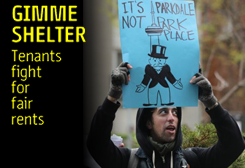UNIONS 2.0
Workers and unions try out new ways to build power and solidarity

Julie Eaton, member of Lobster 207
MAYBE THE FUTURE OF UNIONS LIES IN NOT BEING UNIONS. Two researchers from the MIT (Massachusetts Institute of Technology) say it’s a real possibility.
Megan Larcom and Jenny Weissbourd carried out a survey of 4000 workers in 2018. They found signs of a “new worker activism” expressing itself in two very different ways.
First, there was a surprising 17% uptick, from 33% to 50%, in the number of workers who would join a union if given the opportunity.
Second, the two found growing interest in “alt-labour”: various ways workers can have direct input into their workplace and work life without joining a union.
Alt-labour abounds
At Google, for example, workers are demanding a fair way of resolving workplace discrimination claims, calling for transparency and equity in pay between genders, and asking for employee representation on the company’s board.
InstaCart contractors petitioned the delivery company’s CEO to stop stealing their tips. Marriott workers went on strike to improve their wages and access to training for new technologies under the slogan “One job should be enough.”
OUR Walmart, an independent employee organization is starting to use artificial intelligence to inform workers at Walmart and other firms of their rights. Coworker.org helps baristas at Starbucks petition for operational and workplace improvements across their entire network of stores.
The Independent Drivers Guild and Uber in New York City work together to advocate for drivers through a works council, tackling issues important to drivers (such as tipping) and to customers and company (such as the efficacy of the drivers’ app).
Workers can also build power for themselves and influence the direction of their work if they have a stake in the ownership of a company. Lobster 207, the Maine worker-owned lobstering co-operative, established by the International Association of Machinists is a good example of how workers can change the dynamics of power in the economy through ownership.
Workers now want forms of voice and representation that go well beyond traditional collective bargaining. Workers want more individual benefits and services that carry across jobs—including health care, retirement, training, and job search assistance.
They also expressed interest in new options for participating in decision-making to improve operations at their organizations, from enterprise-wide councils or committees to seats on company boards of directors.
High-touch vs. high-tech
For much of the twentieth century, traditional labour unions, based on face-to-face membership drives, served as the main outlet for worker power and voice. The researchers call that model “high touch.” They call the new alt-labour models, often based on digital connections, “high tech.”
Some high tech efforts build digital platforms to connect workers and build up a support base as broad as traditional unions. Instead of door-to-door organizing they are using platforms (often involving technology) to try to identify common interests and connect people who wouldn’t otherwise know that they share similar experiences. These organizations include Coworker.org, the Freelancers Union, and OUR Walmart.
Nothing new for unions
Unions have been here before. They have evolved and reinvented themselves many times. Many are now experimenting and innovating to bring together a more scattered workforce full of gig workers, temps, and independent contractors around a shared cause.
For example, the International Association of Machinists (IAM) is organizing fishermen in Maine through the first-of-its-kind lobstermen’s union. The Service Employees International Union (SEIU) has organized traveling home health workers by going door to door to find them and get them involved.
SEIU also has created a community action body within the union for those who may not currently be in a union job, as service workers often cycle through multiple jobs with different arrangements. The community action body allows them to take part in policy campaigns and other union causes and stay up to date even during the employment periods in which they are not under a union contract.
Canadian effort
In Canada, Unifor’s Community Chapters are a new way that workers can have some of the benefits of a union, even if they don’t work somewhere that has a union or where they can form one.
Potential community chapters could also include workers in workplaces where unionizing campaigns have not yet succeeded; workers in precarious jobs; unemployed workers; students and any other group of workers hoping to improve their economic and social conditions
Not your grandparents union
“The labour movement is pretty self-aware about the fact that it’s in crisis,” says Larcom. “It’s sort of a ‘Phoenix rising from the ashes’ moment where you have all these new organizations that are testing really bold interventions and talking in new ways about what the labour-management relationship could look like."
“We need to have both the high-touch model of traditional unions and the high-tech model of new labour organizations together,” says Weissbourd, “and I don’t think anyone’s figured out how to do both yet. I think that’s something valid to chase after on behalf of workers to build scale and power.”
As Harvard researchers Richard Freeman and Kelsey Hilbrich note: “If unions have a future in the U.S., they will not be your parents’ or grandparents’ union movement but one that fits today’s internet-based society, global economy, and financial world.”
- 30 -













Add new comment